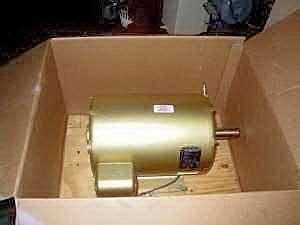buce
Cast Iron
- Joined
- Sep 18, 2007
- Location
- Everett WA
Motor Specs:
15 HP Baldor AC Electric Motor.
As new condition; in its original shipping carton and bolted to its original wooden shipping base. $375.00
Baldor's elite line of high efficiency motors.
Baldor catalog number EM2513T.
15 HP, 1765 RPM, 3PH, 60HZ, 254T, 3938M, OPSB, F1.
Volts; 230/460. Amps: 35.4/17.7.
NEMA Nom. Efficiency: 93%.
217.00 lbs.
Heavy duty frame; ball bearings; Moisture resistant ISR (Inverter Spike Resistant); copper windings.
Low-loss electrical lamination grade steel.
This will operate in a rural setting at the end of a long street on a single-phase line that supplies 7 or 8 houses. Our shop electrical panel is 200 amp.
We want to be as kind to our neighbors as possible so we are opting for a pony motor start system.
I'm thinking that with a single-phase pony motor we can rig its centrifugal switch to (through a relay) switch power to the coil of the contactor for the 15hp idler only after it is up to speed. Using the auxiliary contacts of either the 15hp contactor or the pony contactor we can prevent both the pony and idler motors from restarting automatically after power outages… which occur frequently in our area. We can also us the auxiliary contacts to turn the pony motor off after power is applied to the idler.
This would give us a single momentary contact push button to turn it on.
My immediate questions are:
What size circuit breaker is needed in our feed?
How many amps should the contactor for the 15hp idler be rated for?
Once it is up and running without balancing caps I would follow the procedure in the Fitch Williams design for a 10 hp converter to add the balancing caps.
What hp rating on the 3-phase output side should we label this thing?
Am I missing things that will cause me trouble?
Thanks in advance
Bruce
15 HP Baldor AC Electric Motor.
As new condition; in its original shipping carton and bolted to its original wooden shipping base. $375.00
Baldor's elite line of high efficiency motors.
Baldor catalog number EM2513T.
15 HP, 1765 RPM, 3PH, 60HZ, 254T, 3938M, OPSB, F1.
Volts; 230/460. Amps: 35.4/17.7.
NEMA Nom. Efficiency: 93%.
217.00 lbs.
Heavy duty frame; ball bearings; Moisture resistant ISR (Inverter Spike Resistant); copper windings.
Low-loss electrical lamination grade steel.
This will operate in a rural setting at the end of a long street on a single-phase line that supplies 7 or 8 houses. Our shop electrical panel is 200 amp.
We want to be as kind to our neighbors as possible so we are opting for a pony motor start system.
I'm thinking that with a single-phase pony motor we can rig its centrifugal switch to (through a relay) switch power to the coil of the contactor for the 15hp idler only after it is up to speed. Using the auxiliary contacts of either the 15hp contactor or the pony contactor we can prevent both the pony and idler motors from restarting automatically after power outages… which occur frequently in our area. We can also us the auxiliary contacts to turn the pony motor off after power is applied to the idler.
This would give us a single momentary contact push button to turn it on.
My immediate questions are:
What size circuit breaker is needed in our feed?
How many amps should the contactor for the 15hp idler be rated for?
Once it is up and running without balancing caps I would follow the procedure in the Fitch Williams design for a 10 hp converter to add the balancing caps.
What hp rating on the 3-phase output side should we label this thing?
Am I missing things that will cause me trouble?
Thanks in advance
Bruce



